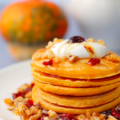If you’re a fan of Korean cuisine or just looking to try something new, you’ll love this Korean pancake recipe. Known as Pajeon or Haemul Pajeon, these savory pancakes are packed with flavor and make a perfect appetizer or side dish.
In this article, we’ll explore the origins of Pajeon, discuss the ingredients and steps to make this delicious dish, and provide some helpful tips along the way. So, let’s dive in and discover the secrets to creating the perfect Korean pancake!
What is Pajeon?
Pajeon, also known as green onion pancakes or scallion pancakes, is a popular Korean dish. It gets its name from the main ingredient used in the batter, which is green onions or scallions.
In addition to green onions, Pajeon is typically made with a combination of other ingredients such as all-purpose flour, water, egg, and seafood. The seafood can include squid, prawns, clams, mussels, or even oysters, depending on your preference.
The Difference Between Pajeon and Haemul Pajeon
While Pajeon refers to the pancakes made with green onions, when you add seafood to the mix, it becomes Haemul Pajeon. The addition of seafood adds a delicious depth of flavor and makes the dish even more satisfying.
You can choose to include your favorite seafood options, such as squid, prawns, clams, or a combination of them. If you have any allergies or dietary restrictions, feel free to omit the seafood and focus on the other ingredients for a vegetarian version.
Ingredient
- 1 cup all-purpose flour
- 1 cup water
- 1 large egg
- 1/2 teaspoon salt
- 1/4 teaspoon black pepper
- 2 green onions, thinly sliced
- 1/2 cup chopped vegetables (such as zucchini, carrots, or bell peppers)
- 1/2 cup chopped seafood (such as shrimp or squid) or cooked meat (optional)
- Vegetable oil for frying
- Soy sauce or dipping sauce for serving (optional)
Korean pancakes recipe
Step 1. Making the Pancake Batter
To start, combine the all-purpose flour, water, egg, and sea salt in a large bowl. Whisk the ingredients together until you have a smooth batter. If you’re using seafood, make sure it’s cleaned and prepared before adding it to the batter. Chop the green onions into small pieces and mix them into the batter as well. The green onions will add a fresh and aromatic flavor to the pancakes.
Step 2. Cooking the Korean Pancakes
Once your batter is ready, it’s time to cook the pancakes. Heat a non-stick skillet or frying pan over medium-high heat. Add a small amount of cooking oil to prevent the pancakes from sticking. Ladle enough batter into the skillet to create a thin layer, covering the bottom of the pan. Allow the pancakes to cook for about 3-4 minutes on each side, or until they turn golden brown and crispy.
Step 3. Making the Dipping Sauce
While the pancakes are cooking, you can prepare the dipping sauce. In a small bowl, combine the low sodium soy sauce, rice vinegar, sugar, sesame oil, garlic, sesame seeds, and crushed red pepper. Whisk the ingredients together until the sugar is dissolved and all the flavors are well combined. Adjust the seasonings according to your taste preferences. The dipping sauce provides a tangy and savory contrast to the pancakes, enhancing their overall flavor.
Step 4. Serving and Enjoying Korean Pancakes
Once the pancakes are cooked to perfection, transfer them to a serving platter. Cut them into wedges or bite-sized pieces for easy sharing. Serve the pancakes warm with the dipping sauce on the side. The combination of the crispy pancakes and the flavorful dipping sauce is simply irresistible. You can enjoy these pancakes as an appetizer, side dish, or even as a main course if you prefer.
Tips for Making Perfect Korean Pancakes
Here are some tips to help you make the perfect Korean pancakes:
- Use sparkling water: For a crispier texture, consider using sparkling water instead of regular water in the pancake batter. It adds a subtle fizz and enhances the overall crunchiness of the pancakes.
- Adjust cooking temperature: The cooking temperature may vary depending on your stovetop and the type of pan you use. Adjust the heat accordingly to prevent the pancakes from burning or turning out too soggy. A medium-high heat is usually a good starting point.
- Experiment with ingredients: Feel free to experiment with different seafood options or add a small amount of minced beef for additional flavor. Customize the pancakes to suit your taste preferences and dietary needs.




